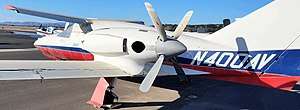Avtek 400A
The Avtek 400A was an American prototype turboprop-powered business aircraft developed in the early 1980s. It was of unusual and distinctive configuration: a low-wing monoplane with two pusher engines mounted above the wings, and a large canard mounted atop the forward fuselage. The aircraft's sleek, futuristic design earned it a guest appearance on the Airwolf TV series as the X-400, the plane used by the villain Lou Stappleford in the episode Eagles.
| Avtek 400A | |
|---|---|
 | |
| Prototype At KCMA in 2019 | |
| Role | Business aircraft |
| Manufacturer | Avtek |
| Designer | Al Mooney |
| First flight | September 17, 1984 |
| Number built | 1 |
The Avtek's structure made extensive use of advanced composite materials throughout.
In 1998, Avtek declared bankruptcy without the prototype having completed the testing required for US FAA type certification. The company's assets were purchased by AvtekAir, who as of 2004 planned to revive the project under the designation AvtekAir 9000T.
Specifications (Avtek 400A pre-production prototype)
Data from Jane's All the World's Aircraft 1988-89[1]
General characteristics
- Crew: 1
- Capacity: 5-9 passengers
- Length: 39 ft 4 in (11.99 m)
- Wingspan: 35 ft 0 in (10.67 m)
- Height: 11 ft 5 in (3.47 m)
- Wing area: 144 sq ft (13.4 m2) inc. foreplane
- Airfoil: Avtek 12
- Empty weight: 3,779 lb (1,714 kg)
- Max takeoff weight: 6,499 lb (2,948 kg)
- Powerplant: 1 × Pratt & Whitney Canada PT6A-3L turboprop, 680 hp (507 kW) LH rotation
- Powerplant: 1 × Pratt & Whitney Canada PT6A-3R turboprop, 680 hp (507 kW) RH rotation
- Propellers: 4-bladed Hartzell constant-speed fully feathering pusher propellers, 6 ft 4 in (1.93 m) diameter
Performance
- Maximum speed: 255 kn (293 mph, 472 km/h)
- Cruise speed: 297 kn (342 mph, 550 km/h) at 10,000 ft (3,000 m)
- 364 kn (674 km/h; 419 mph) at 22,000 ft (6,700 m)
- 338 kn (626 km/h; 389 mph) at 41,000 ft (12,000 m)
- Stall speed: 83 kn (96 mph, 154 km/h)
- Range: 1,038 nmi (1,194 mi, 1,922 km) with NBAA/IFR reserves
- Service ceiling: 42,490 ft (12,950 m)
- Rate of climb: 4,630 ft/min (23.52 m/s)
See also
Aircraft of comparable role, configuration and era
- AAC Angel
- AASI Jetcruzer
- Beechcraft Starship
- Embraer/FMA CBA 123 Vector
- OMAC Laser 300
- Piaggio P.180 Avanti
References
- John W.R. Taylor, ed. (1988). Jane's All the World's Aircraft 1988-89. London: Jane's Information Group. ISBN 0-7106-0867-5.
Further reading
- Taylor, Michael J. H. (1989). Jane's Encyclopedia of Aviation. London: Studio Editions. p. 916.